The Development of Limestone Weathering Rind in a Proglacial Environment of the Hallstätter Glacier
Abstract
:1. Introduction
2. Materials and Methods
2.1. Study Site
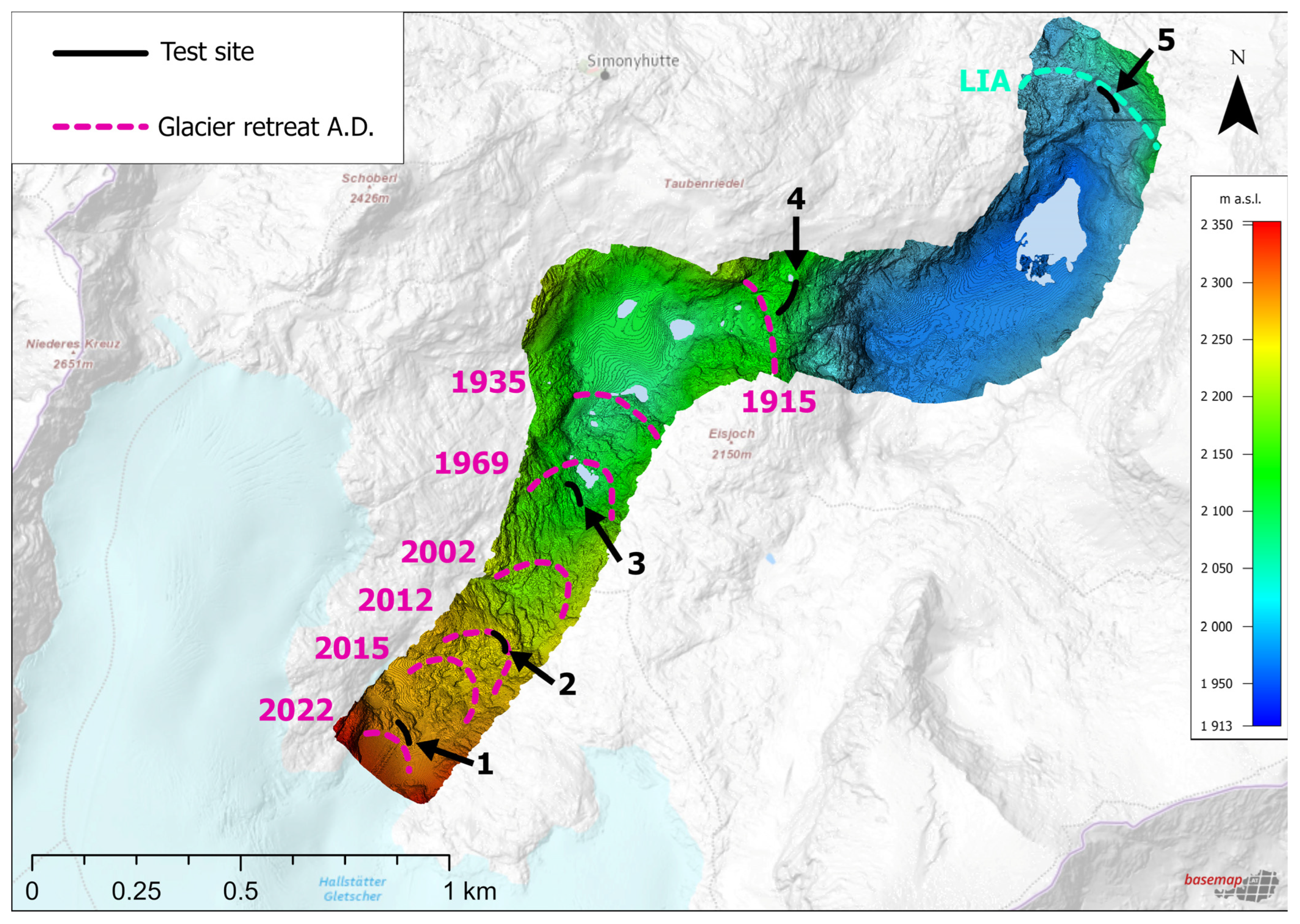
2.2. Methods
2.2.1. Location and Dating of Test Sites
2.2.2. Micro-Roughness, Rock Strength, and Spectral Measurements
2.2.3. UAV and GNSS RTK Surveys
2.2.4. Analyses of Rock Samples
Microbiology Analyses
3. Results
3.1. Rock Surface Micro-Roughness and Strength
3.2. Spectral Reflectance
3.3. Petrography and Micro-Structures
3.3.1. General Weathering Rind Characteristics
3.3.2. Micro-Structures at Sites 1 and 2
3.3.3. Micro-Structures at Sites 3–5
3.4. Preliminary Detection of Microorganisms on the Weathering Rind
4. Discussion
4.1. Previous Weathering Studies in Proglacial Environments
4.2. Interpretation of Micro-Structures
4.3. Interpretation of Spectral Reflectance
4.4. The Role of Microorganisms in Micro-Structure Development and Infill
5. Conclusions
Author Contributions
Funding
Data Availability Statement
Acknowledgments
Conflicts of Interest
References
- Benn, D.; Evans, D.J.A. Glaciers and Glaciations; Routledge: London, UK, 2010. [Google Scholar]
- WGMS. World Glacier Monitoring Service. 2022. Available online: https://wgms.ch/ (accessed on 20 December 2022).
- Hall, K.; Thorn, C.; Sumner, P. On the persistence of ‘weathering’. Geomorphology 2012, 149–150, 1–10. [Google Scholar] [CrossRef]
- Kump, L.R.; Brantley, S.L.; Arthur, M.A. Chemical weathering, Atmospheric CO2, and Climate. Annu. Rev Earth Planet. Sci. 2000, 28, 611–667. [Google Scholar] [CrossRef] [Green Version]
- Kirchner, J.S.; Lettmann, K.A.; Schnetger, B.; Wolff, J.-O.; Brumsack, H.-J. Identifying Appropriate Locations for the Accelerated Weathering of Limestone to Reduce CO2 Emissions. Minerals 2021, 11, 1261. [Google Scholar] [CrossRef]
- Thorn, C.E.; Darmody, R.G.; Dixon, J.C.; Schlyter, P. The chemical weathering regime of Kärkevagge, arctic–alpine Sweden. Geomorphology 2001, 41, 37–52. [Google Scholar] [CrossRef]
- Dreybrodt, W. The Role of Dissolution Kinetics in the Development of Karst Aquifers in Limestone: A Model Simulation of Karst Evolution. J. Geol. 1990, 98, 639–655. [Google Scholar] [CrossRef]
- Ford, D.; Williams, P. Kart Hydrology and Geomorphology; Wiley & Sons: Chichester, UK, 2007. [Google Scholar]
- Anderson, S.P.; Drever, J.I.; Humphrey, N.F. Chemical weathering in glacial environments. Geology 1997, 25, 399–402. [Google Scholar] [CrossRef]
- Hallet, B. Subglacial regelation water film. J. Glaciol. 1979, 23, 321–334. [Google Scholar] [CrossRef]
- Gunn, J. Encyclopedia of Caves and Karst Science; Routlege: New York, NY, USA, 2003. [Google Scholar]
- Day, M.J. Morphology and distribution of residual limestone hills (mogotes) in the karst of northern Puerto Rico. Geol. Soc. Am. Bull. 1978, 89, 426–432. [Google Scholar] [CrossRef]
- Brook, G.; Ford, D. The origin of labyrinth and tower karst and the climatic conditions necessary for their development. Nature 1978, 275, 493–496. [Google Scholar] [CrossRef]
- Dunkerley, D.L. Lithology and micro-topography in the Chillagoe karst, Queensland, Australia. Z. Für Geomorphol. 1983, 27, 191–204. [Google Scholar] [CrossRef]
- Hanna, F.K. A technique for measuring the rate of erosion of cave passages. Proc. Univ. Bristol Spelaeol. Soc. 1966, 11, 83–86. [Google Scholar]
- Trudgill, S.T. Surface lowering and landform evolution on Aldabra Philosophical Transactions of the Royal Society of London. Biol. Sci. Ser. B 1979, 286, 35–45. [Google Scholar]
- Spate, A.P.; Jennings, J.N.; Smith, D.I.; Greenaway, M.A. The micro-erosion meter: Use and limitations. Earth Surf. Process. Landf. 1985, 10, 427–440. [Google Scholar] [CrossRef]
- Shakesby, R.A.; Walsh, R.P.D. Micro-erosion meter measurements of erosion of limestone, Oxwich Point, Gower: Some technical considerations and preliminary results. Cambria 1986, 13, 213–234. [Google Scholar]
- Cucchi, F.; Fabio, F.; Ulcigrai, F. Degradation by dissolution of carbonate rocks. Acta Carsol. 1994, 23, 55–62. [Google Scholar]
- Muhammad, R.F.; Beng, Y.E. Estimating limestone dissolution rates in the Kinta and Lenggong Valleys using the micro erosion meter; a preliminary study. Bull. Geol. Soc. Malays. 2002, 45, 253–256. [Google Scholar] [CrossRef]
- Stephenson, W.J.; Finlayson, B.L. Measuring erosion with the micro-erosion meter—Contributions to understanding landform evolution. Earth-Sci. Rev. 2009, 95, 53–62. [Google Scholar] [CrossRef]
- Moses, C.; Robinson, D.; Barlow, J. Methods for measuring rock surface weathering and erosion: A critical review. Earth-Sci. Rev. 2014, 135, 141–161. [Google Scholar] [CrossRef]
- Viles, H.A.; Moses, C.A. Weathering nanomorphologies: Their experimental production and use as indicators of carbonate stone decay. Q. J. Eng. Geol. Hydrol. 1998, 31, 347–357. [Google Scholar] [CrossRef]
- Dąbski, M.; Woronko, B.; Fabijańska, P.; Otto, J.C. Micro-weathering of limestone surfaces in a foreland of Hallstätter Glacier (Dachstein, Austria). Geogr. Ann. Ser. A Phys. Geogr. 2019, 101, 277–292. [Google Scholar] [CrossRef]
- Mandl, G.W.; Matura, A. Geologische Karte der Republik Österreich 1: 50 000. 127 Schladming; Geologische Bendesanstalt: Vienna, Austria, 1995. [Google Scholar]
- Haas, J.; Lobitzer, H.; Monostori, M. Characteristics of the Lofer cyclicity in the type locality of the Dachstein Limestone (Dachstein Plateau, Austria). Facies 2007, 53, 113–126. [Google Scholar] [CrossRef]
- Krystyn, L.; Mandl, G.W.; Schauer, M. Growth and termination of the Upper Triassic platform margin of the Dachstein area (Northern Calcareous Alps, Austria). Austrian J. Earth Sci. 2009, 102, 23–33. [Google Scholar]
- Rode, M.; Sass, O.; Kellerer-Pirklbauer, A.; Schnepfleitner, H.; Gitschthaler, C. Permafrost distribution and conditions at the headwalls of two receding glaciers (Schladming and Hallstatt glaciers) in the Dachstein Massif, Northern Calcareous Alps, Austria. Cryosphere 2020, 14, 1173–1186. [Google Scholar] [CrossRef] [Green Version]
- Klimaregion Dachsteingruppe, 2018. Das Land Steiermark. Available online: http://www.umwelt.steiermark.at/cms/beitrag/10023730/25206/ (accessed on 28 June 2018).
- Bruhm, K.; Buchroithner, M.; Hetze, B. True-3D Visualization of Glacier Retreat in the Dachstein Massif, Austria: Cross-Media. Hard- and Softcopy Displays. In Developments in 3D Geo-Information Science. Lecture Notes in Geoinformation and Cartography; Neutens, T., De Maeyer, P., Eds.; Springer: Berlin/Heidelberg, Germany, 2010. [Google Scholar]
- Fischer, A.; Seiser, B.; Stocker-Waldhuber, M.; Mitterer, C.; Abermann, J. Tracing glacier changes in Austria from the Little Ice Age to the present using a lidar-based high-resolution glacier inventory in Austria. Cryosphere 2015, 9, 753–766. [Google Scholar] [CrossRef] [Green Version]
- Fischer, A.; Seiser, B.; Stocker-Waldhuber, M.; Mitterer, C.; Abermann, J. The Austrian Glacier Inventories GI 1 (1969), GI 2 (1998), GI 3 (2006), and GI LIA in ArcGIS (shapefile) format. PANGAEA. Supplement to: Fischer, A.; Seiser, B.; Stocker-Waldhuber, M.; Mitterer, C.; Abermann, J. Tracing glacier changes in Austria from the Little Ice Age to the present using a lidar-based high-resolution glacier inventory in Austria. Cryosphere 2015, 9, 753–766. [Google Scholar]
- Buckel, J.; Otto, J.-C. The Austrian Glacier Inventory GI 4 in ArcGis (shapefile) format. PANGAEA. Supplement to: Buckel, J.; Otto, J.-C.; Prasicek, G.; Keuschnig, M. Glacial lakes in Austria—Distribution and formation since the Little Ice Age. Glob. Planet Chang. 2018, 164, 39–51. [Google Scholar] [CrossRef]
- Groß, G. Der Flächenverlust der Gletscher in Österreich 1850-1920-1969 (GI 1). Z. Für Gletsch. Und Glazialgeol. 1987, 23, 131–141. [Google Scholar]
- Dąbski, M. Rock surface micro-roughness, Schmidt hammer rebound and weathering rind thickness within LIA Skalafellsjokull foreland, SE Iceland. Pol. Polar Res. 2014, 35, 99–114. [Google Scholar] [CrossRef] [Green Version]
- Dąbski, M. Application of the Handysurf E-35B electronic profilometer for the study of weathering micro-relief in glacier forelands in SE Iceland. Acta Geol. Pol. 2015, 65, 389–401. [Google Scholar] [CrossRef] [Green Version]
- Dąbski, M.; Tittenbrun, A. Time-dependant surface deterioration of glacially abraded basaltic boulders deposited by Flaajokull, SE Iceland. Jökull 2013, 63, 55–70. [Google Scholar] [CrossRef]
- Sambrook, J.; Russel, D.W. Molecular Cloning: A Laboratory Manual; Cold Spring Harbor Laboratory Press: Cold Spring Harbor, NY, USA, 2001. [Google Scholar]
- Czapek, F. Untersuchungen über die Stickstoffgewinnung und Eiweifsbildung der Pflanzen. Beiträge Zur Chem. Physiol. Und Pathol. 1901–1902, 1, 538–560. [Google Scholar]
- Tsai, F.; Philpot, W. Derivative Analysis of Hyperspectral Data. Remote Sens. Environ. 1998, 66, 41–51. [Google Scholar] [CrossRef]
- Moghtaderi, A.; Moore, F.; Taghavi, S.M.; Rezaei, R. The application of ASTER imageries and mathematical evaluation method in detecting cyanobacteria in biological soil crust, Chadormalu area, central Iran. Iran. J. Sci. Technol. A1 2011, 35, 13–28. [Google Scholar]
- McCarroll, D. A new instrument and techniques for the field measurement of rock surface roughness. Zeischrift Für Geomorphol. 1992, 36, 69–79. [Google Scholar] [CrossRef]
- McCarroll, D.; Nesje, A. Rock surface roughness as an indicator of degree of rock surface weathering. Earth Surf. Process. Landf. 1996, 21, 963–977. [Google Scholar] [CrossRef]
- Porter, S.C. Weathering rinds as a relative-age criterion: Application to subdivision of glacial deposits in the Cascade Range. Geology 1975, 3, 101–104. [Google Scholar] [CrossRef]
- Chinn, T.J.H. Use of Rock Weathering-Rind Thickness for Holocene Absolute Age-Dating in New Zealand. Arct. Alp. Res. 1981, 13, 33–45. [Google Scholar] [CrossRef]
- Nicholson, D.T. Holocene microweathering rates and processes on ice-eroded bedrock, Roldal area, Hardangervidda, southern Norway. In Periglacial and Paraglacial Processes and Environments; Knight, J., Harrison, J., Eds.; Geological Society, Special Publications 320: London, UK, 2009. [Google Scholar]
- Matthews, J.A.; Shakesby, R.A. The status of the Little Ice Age is southern Norway: Relative-age dating of neoglacial moraines with Schmidt hammer and lichenometry. Boreas 1984, 13, 333–346. [Google Scholar] [CrossRef]
- Winkler, S. The Schmidt hammer as a relative-age dating technique: Potential and limitations of its application on Holocene moraines in Mt. Cook National Park, Southern Alps, New Zealand. N. Z. J. Geol. Geophys. 2005, 48, 105–116. [Google Scholar] [CrossRef]
- Shakesby, A.A.; Matthews, J.A.; Owen, G. The Schmidt hammer as a relative-age dating tool and its potential for calibrated-age dating in Holocene glaciated environments. Quat. Sci. Rev. 2006, 25, 2846–2867. [Google Scholar] [CrossRef]
- Evans, D.J.A.; Archer, S.; Wilson, D.J.H. A comparison of the lichenometric and Schmidt hammer dating techniques based on data from the proglacial areas of some Icelandic glaciers. Quat. Sci. Rev. 1999, 18, 13–41. [Google Scholar] [CrossRef]
- Etienne, S. The role of biological weathering in periglacial areas: A study of weathering rinds in south Iceland. Geomorphology 2002, 47, 75–86. [Google Scholar] [CrossRef]
- Matthews, J.A.; Owen, G. Holocene Chemical Weathering, Surface Lowering and Rock Weakening Rates on Glacially Eroded Bedrock Surfaces in an Alpine Periglacial Environment, Jotunheimen, Southern Norway. Permafr. Periglac. Process. 2011, 22, 279–290. [Google Scholar] [CrossRef]
- Sharp, R.P. Semiquantitative differentiation of glacial moraines near Convict Lake, Sierra Nevada, California. J. Geol. 1969, 77, 68–91. [Google Scholar] [CrossRef]
- Anderson, L.W.; Anderson, D.S. Weathering Rinds on Quartzarenite Clasts as a Relative-Age Indicator and the Glacial Chronology of Mount Timpanogos, Wasatch Range, Utah. Arct. Alp. Res. 1981, 13, 25–31. [Google Scholar] [CrossRef]
- Gellatly, A.F. The Use of Rock Weathering-Rind Thickness to Redate Moraines in Mount Cook National Park, New Zealand. Arct. Alp. Res. 1984, 16, 225–232. [Google Scholar] [CrossRef]
- André, M.-F. Rates of post-glacial rock weathering on glacially scoured outcrops (Abisko-Riksgransen area, 688 N). Geogr. Ann. 2002, 84A, 139–150. [Google Scholar] [CrossRef]
- Sumner, P.; Nel, W.; Holness, S.; Boelhouwers, J. Rock weathering characteristics as relative-age indicators for glacial and post-glacial landforms on Marion Island. South Afr. Geogr. J. 2002, 84, 153–157. [Google Scholar] [CrossRef]
- Mahaney, W.C.; Fairén, A.G.; Dohm, J.M.; Krinsley, D.H. Weathering rinds on clasts: Examples from Earth and Mars as short and long term recorders of paleoenvironment. Planet. Space Sci. 2012, 73, 243–253. [Google Scholar] [CrossRef]
- Ciccazzo, S. Dynamic of Bacterial Community Colonization in High-Altitude Mountain Environments. Ph.D. Thesis, Universita degli Studi di Milano, Milan, Italy, 2014. [Google Scholar]
- Dorn, R.I.; Jeong, A. Rock Coating and Weathering-Rind Development at the Edge of Retreating Glaciers: An Initial Study. Yearb. Assoc. Pac. Coast Geogr. 2018, 80, 66–96. [Google Scholar] [CrossRef]
- Dixon, J.C.; Thorn, C.E.; Darmody, R.G.; Campbell, S.W. Weathering rinds and rock coatings from an Arctic alpine environment, northern Scandinavia. GSA Bull. 2002, 114, 226–238. [Google Scholar] [CrossRef]
- Dorn, R.I.; Mahaney, W.C.; Krinsley, D.H. Case Hardening: Turning Weathering Rinds into Protective Shells. Elements 2017, 13, 165–169. [Google Scholar] [CrossRef]
- Woronko, B. Frost weathering versus glacial grinding in the micromorphology of quartz sand grains: Processes and geological implications. Sediment. Geol. 2016, 335, 103–119. [Google Scholar] [CrossRef]
- Konhauser, K. Introduction to Geomicrobiology; Blackwell Publishing Company: Malden, MA, USA, 2007. [Google Scholar]
- Ehrlich, H.L.; Newman, D.K. Geomicrobiology; CRC Press Taylor&Francis Group: Boca Raton, FL, USA, 2009. [Google Scholar]
- Li, W.; Zhou, P.P.; Jia, L.P.; Yu, L.-J.; Li, X.-L.; Zhu, M. Limestone Dissolution Induced by Fungal Mycelia, Acidic Materials, and Carbonic Anhydrase from Fungi. Mycopathologia 2009, 167, 37–46. [Google Scholar] [CrossRef]
- Dupraz, C.; Reid, P.; Braissant, O.; Decho, A.W.; Norman, S.R.; Visschert, P.T. Processes of carbonate precipitation in modern microbial mats. Eart-Sci. Rev. 2009, 96, 141–162. [Google Scholar] [CrossRef]
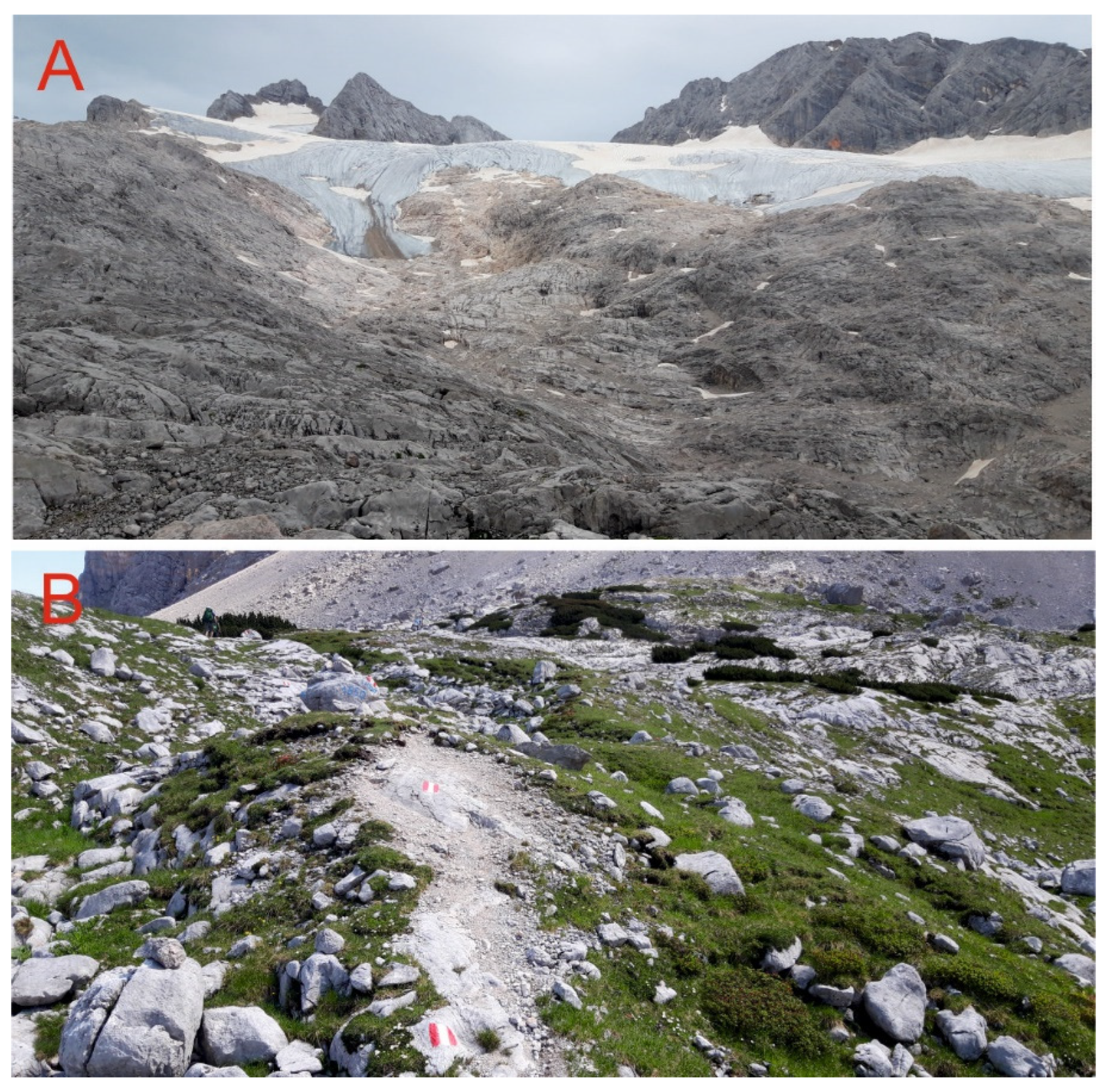

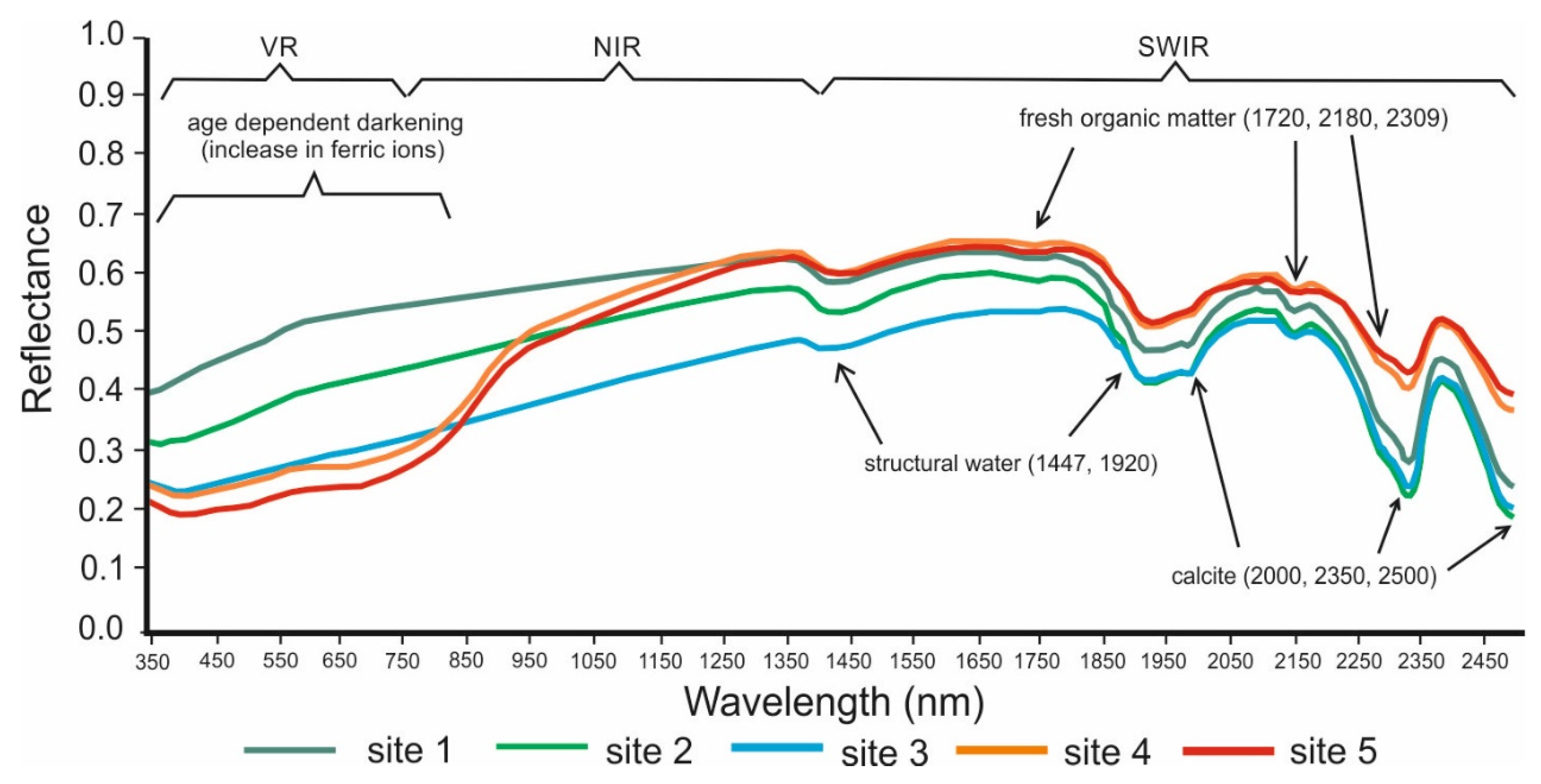
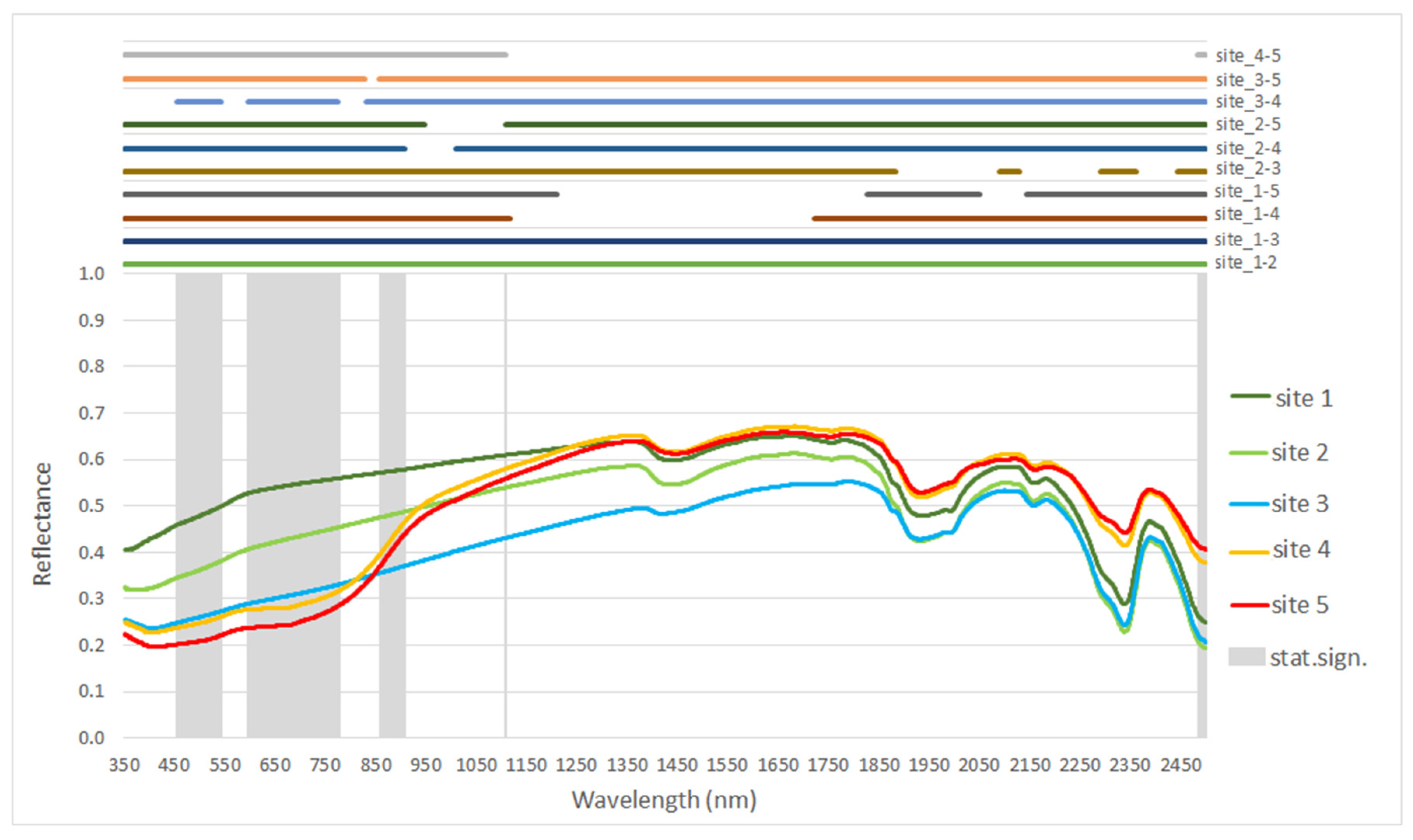

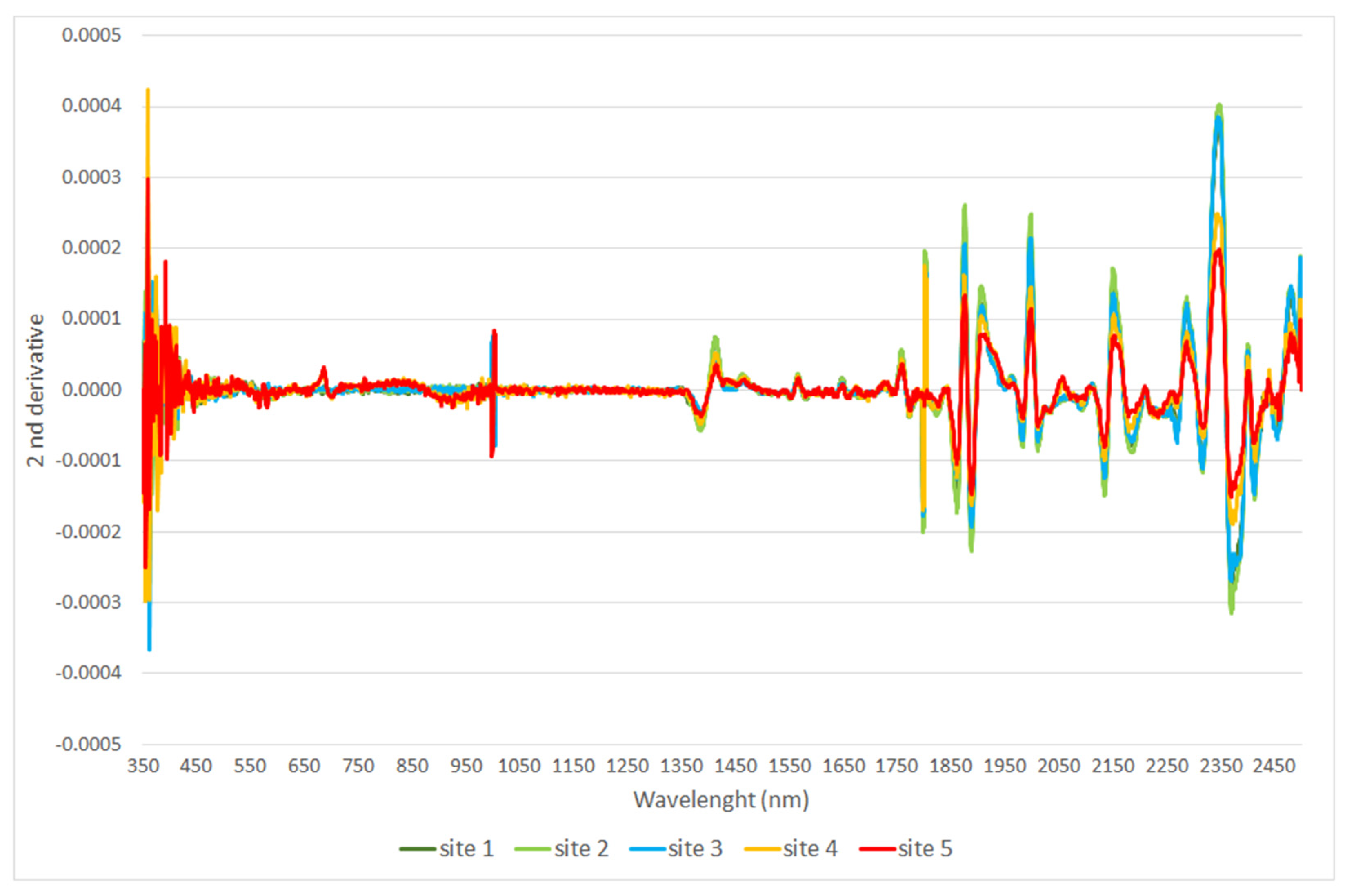



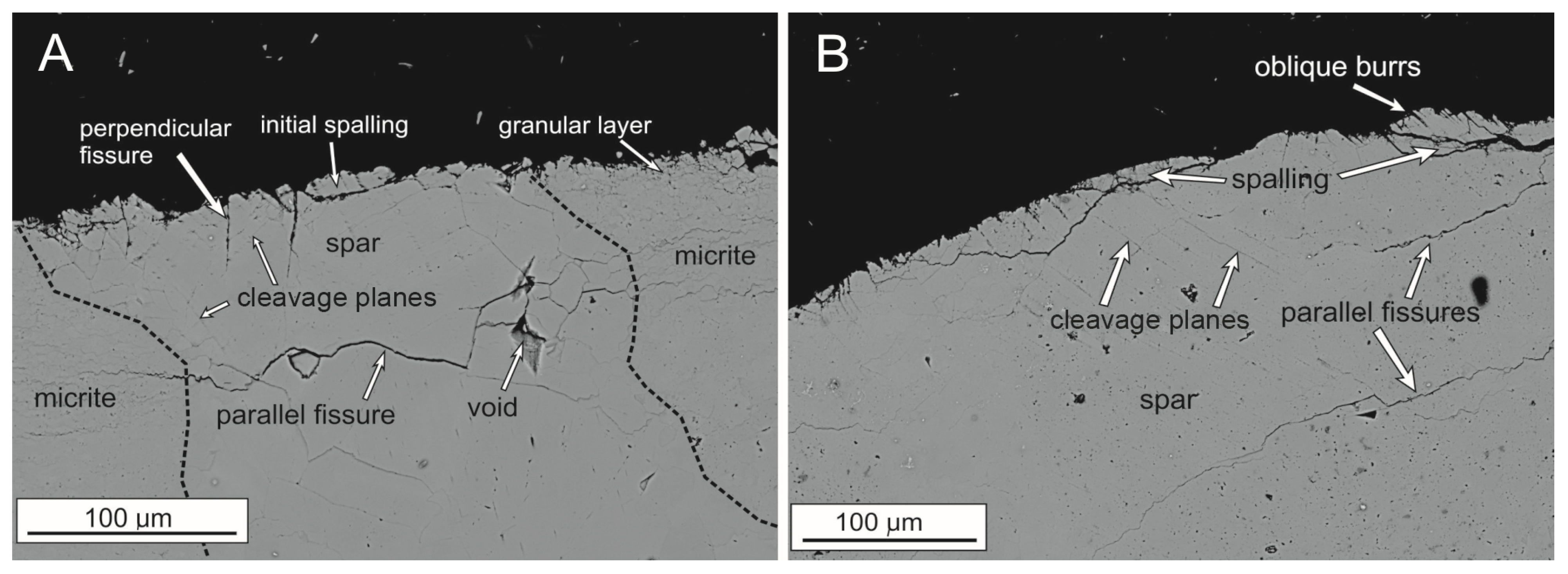
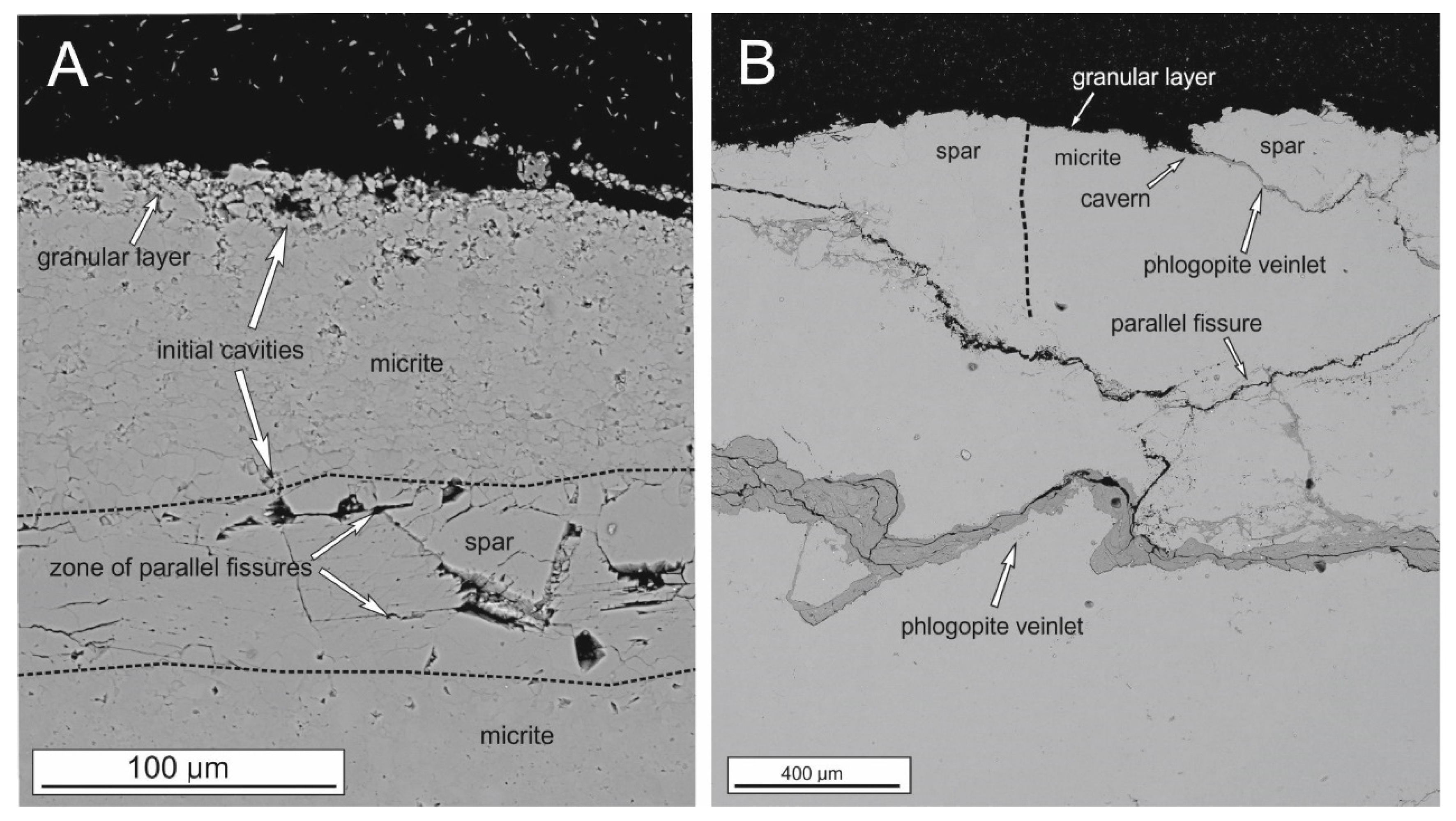
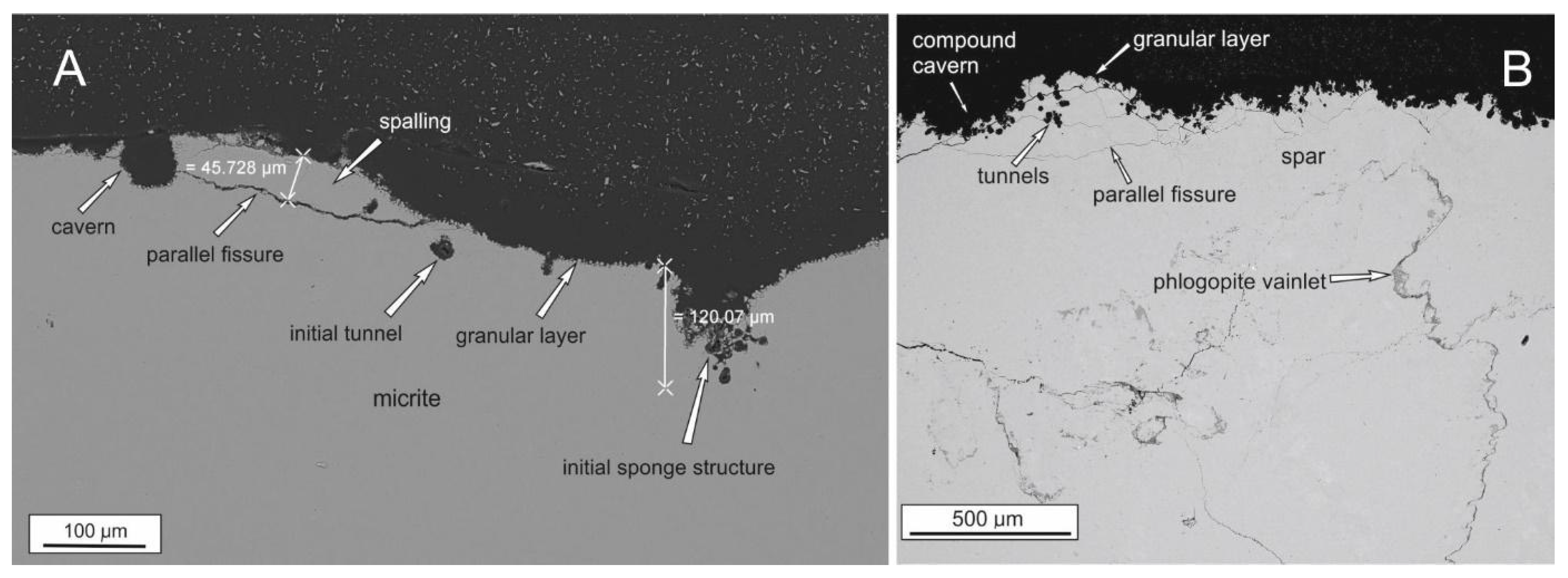
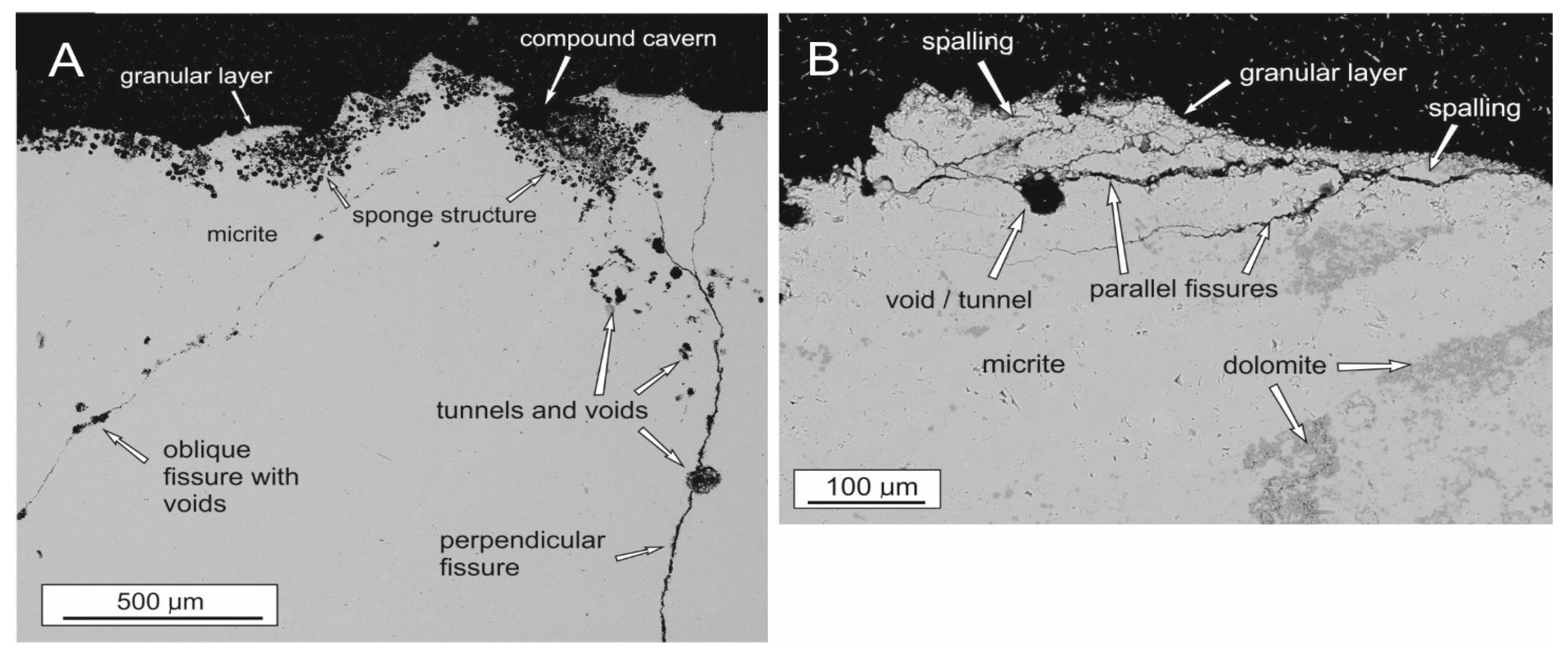
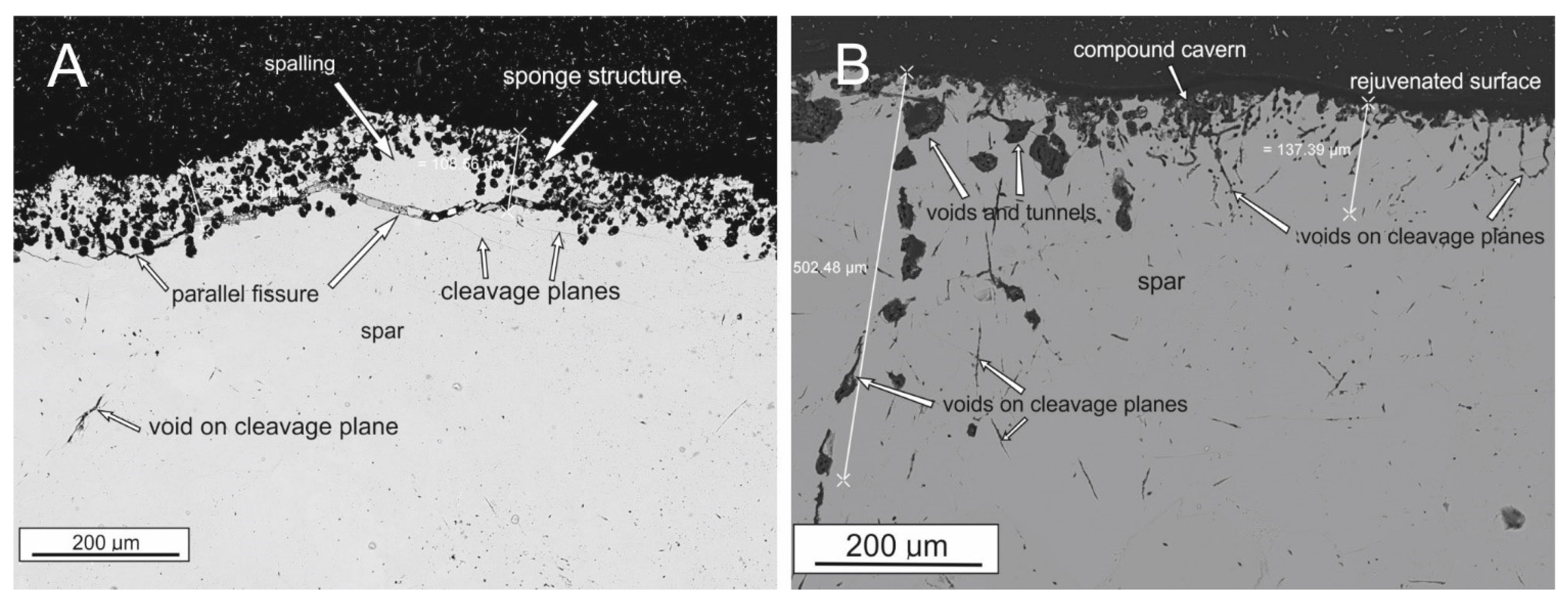

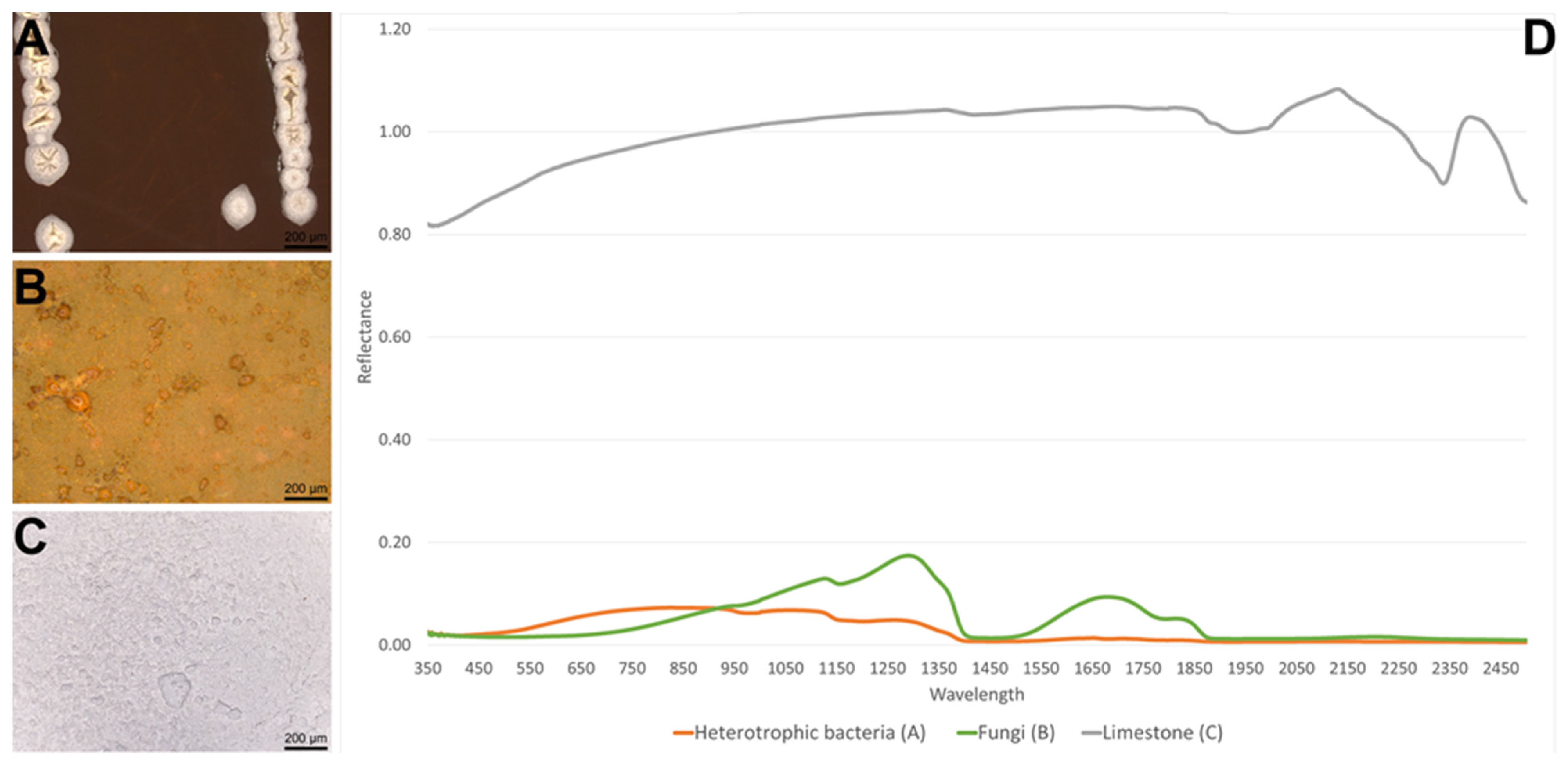


| Site | Latitude | Longitude | Elevation m a.s.l |
|---|---|---|---|
| 1 | 47°29′13″ N | 13°37′07″ E | 2272.9 |
| 2 | 47°29′20″ N | 13°37′18″ E | 2190.0 |
| 3 | 47°29′32″ N | 13°37′27″ E | 2080.3 |
| 4 | 47°29′47″ N | 13°37′51″ E | 2083.3 |
| 5 | 47°30′02″ N | 13°38′28″ E | 1963.8 |
| Site | Granular Layer Thickness (µm) | Grains Diameter (µm) | The Thickness of the Fissured Layer (µm) | Width of Fissures (µm) | Crystal Cleavage | The Thickness of the Sponge Structure (µm) |
|---|---|---|---|---|---|---|
| 1 | 7–100 | 2–12 (up to 20) | 40–100 (rarely down to 1500) | <3 | frequent on spar | absent |
| 2 | 7–200 | 2–12 | 25–300 (rarely up to 1000) | <25 | frequent on spar | absent |
| 3 | 10–50 | 2–15 (up to 20) | <400 (rarely up to 1200) | <5 | infrequent | 50–120 |
| 4 | 10–15 | 2–25 | <150 (only on protruding fragments) | <10 | infrequent | <200 (best developed in concavities; tunnels along veins down to 1000) |
| 5 | <20 | <10 (rarely up to 50) | Best developed on protruding fragments | <5 | In places emphasized by voids along cleavage planes | <300 (best developed in concavities) |
| Site | N | Mean (µm) | Median (µm) | Min (µm) | Max (µm) | SD |
|---|---|---|---|---|---|---|
| 3 | 107 | 23 | 18 | 4 | 89 | 16.1 |
| 4 | 194 | 18 | 16 | 8 | 60 | 8.7 |
| 5 | 156 | 14 | 11 | 4 | 46 | 7.9 |
Disclaimer/Publisher’s Note: The statements, opinions and data contained in all publications are solely those of the individual author(s) and contributor(s) and not of MDPI and/or the editor(s). MDPI and/or the editor(s) disclaim responsibility for any injury to people or property resulting from any ideas, methods, instructions or products referred to in the content. |
© 2023 by the authors. Licensee MDPI, Basel, Switzerland. This article is an open access article distributed under the terms and conditions of the Creative Commons Attribution (CC BY) license (https://creativecommons.org/licenses/by/4.0/).
Share and Cite
Dąbski, M.; Badura, I.; Kycko, M.; Grabarczyk, A.; Matlakowska, R.; Otto, J.-C. The Development of Limestone Weathering Rind in a Proglacial Environment of the Hallstätter Glacier. Minerals 2023, 13, 530. https://doi.org/10.3390/min13040530
Dąbski M, Badura I, Kycko M, Grabarczyk A, Matlakowska R, Otto J-C. The Development of Limestone Weathering Rind in a Proglacial Environment of the Hallstätter Glacier. Minerals. 2023; 13(4):530. https://doi.org/10.3390/min13040530
Chicago/Turabian StyleDąbski, Maciej, Ireneusz Badura, Marlena Kycko, Anna Grabarczyk, Renata Matlakowska, and Jan-Christoph Otto. 2023. "The Development of Limestone Weathering Rind in a Proglacial Environment of the Hallstätter Glacier" Minerals 13, no. 4: 530. https://doi.org/10.3390/min13040530





